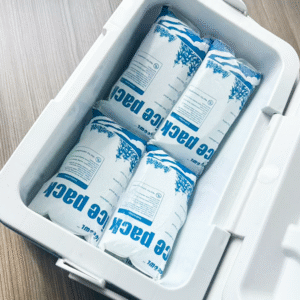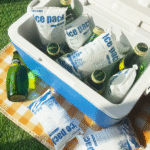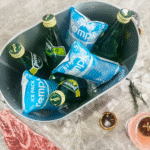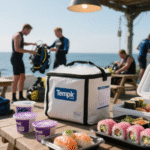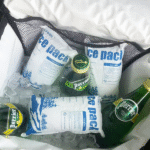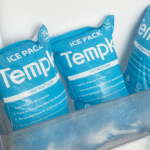Comment emballer la glace sèche pour l'expédition USPS, Step by Step
If you’re looking for how to pack dry ice for shipping USPS, Voici le précis, 2025Processus conforme. Vous apprendrez le 5 limite d'air LB, Étiquettes requises, Et la seule forme USPS a toujours besoin d'air. Vous obtiendrez également une liste de contrôle rapide et un estimateur que vous pouvez intégrer sur votre site.
-
Règles USPS que vous devez suivre (5 limite d'air LB, «Surface uniquement,”Marquages d'adresse)
-
Exactly how to pack and vent a compliant shipper with UN1845 markings
-
Which labels and documents you need for air vs. sol, including STCs
-
Combien de glace sèche à utiliser for 24–72 hours without over‑spending
-
2025 Tendances de la chaîne du froid that can extend hold time and reduce risk
What does USPS require when you ask “how to pack dry ice for shipping USPS”?
Réponse directe
Utiliser un emballage ventilé, Marquez correctement le côté d'adresse, et respecter les limites de service. Le courrier international est interdit. Pour air (Mail prioritaire / express), dry ice is ≤5 lb par envoi postal, with Class 9 étiquette, «Dioxyde de glace sèche / carbone, solide, UN1845,” poids net, contents, plus a Shipper’s Declaration (triplicate) affixed outside. Pour sol (USPS Ground Advantage/Parcel Select), you may exceed 5 lb but must add “Surface Mail Only.”
Details you can trust
Pub 52 Packaging Instruction 9UN sets the limits, ventilation, et marques; §349 confirms the international prohibition et le 5 chapeau d'air en lb. USPS keeps these rules stricter than IATA by continuing to require a Shipper’s Declaration for air, even though IATA’s 2025 dry ice checklist notes cases where a declaration isn’t required. Suivre USPS first.
Étiquettes & forms you need (address side)
Pour l'air (≤5 lb par envoi postal):
-
Classe 9 étiquette de danger
-
«Glace sèche» ou «dioxyde de carbone, solide,»Un1845
-
Poids net de glace carbonique (prefer kg; add lb if you wish)
-
Contents being cooled (Par exemple, “frozen steaks”)
-
Déclaration de l'expéditeur pour les marchandises dangereuses (3 copies) attached externally
Pour le terrain (>5 lb allowed):
-
“Surface Mail Only”
-
UN1845 + poids net + contents (no Class 9, no declaration)
Note on HAZMAT labels in 2024–2025: USPS introduced an oversized “H” icon and 2D barcodes on HAZMAT labels, and updated address‑label rules in Jan 2025 Postal Bulletin. Your software or label vendor should now support these formats.
How to pack dry ice for shipping USPS: what materials work and why?
Réponse directe
Use a rigid outer box and a vent‑capable insulated inner. A foam (EPS / EPP) cooler inside a corrugated outer box is standard. Fermez le couvercle du refroidisseur loosely so CO₂ can vent. À ce jour Jan 27, 2025, USPS requires rigide outer packaging that meets minimum strength: 32 ECT/200‑lb burst (≤20 lb) ou 44 ECT/275‑lb (>20 kg). Évitez les phoques hermétiques.
Pourquoi cela compte
La glace carbonique se sublime en gaz CO₂; trapping it can rupture a package. Venting and structural strength reduce incidents and speed acceptance at retail counters. USPS documented that better packaging rules, plus data signals like STCs, reduced hazmat incidents.
Étape par étape: how to pack dry ice for shipping USPS (air & sol)
-
Pre‑chill the payload. Gelé dans, gelé. Warm items waste ice.
-
Choisir l'isolation. EPS/EPP cooler ≥2″ thick inside a rigide corrugated box (rencontrer 32/44 ECT rules by weight).
-
Doubler & protect. Add a loose plastic liner to prevent condensation from soaking the carton. Do not seal the liner airtight.
-
Place product, then ice. Put product in a leak‑tight primary container. Ajouter la glace sèche ci-dessous, autour, and on top.
-
Leave venting. Close the cooler sans taping it airtight. Tape the extérieur box normally.
-
Mark the address side. Libellé UN1845 + poids net + contents. Ajouter Classe 9 & Déclaration pour air; ajouter “Surface Mail Only” pour sol.
-
Use correct STCs (business shippers). Exemples: 116 (Priority HAZMAT), 760 (PME HAZMAT), 362/184 (Ground Advantage HAZMAT).
Quick service matrix: choose the right USPS path
| USPS Path | Dry Ice Limit | Étiquettes & Docs | Put on address side | Best for you |
|---|---|---|---|---|
| Air (Priority/Express) | ≤ 5 kg par courrier | Classe 9 + Déclaration de l'expéditeur (triplicate) | «Dioxyde de glace sèche / carbone, solide, UN1845», poids net, contents | Fast 1–3 days, smaller ice loads |
| Sol (Ground Advantage/Parcel Select) | >5 kg autorisé | No Class 9; no declaration | “Surface Mail Only” + UN1845 + poids net + contents | Longs routes, larger ice loads |
| International/APO/FPO/DPO | Interdit | - | - | Use non‑USPS options for cross‑border dry‑ice shipments |
Sources: USPS Pub 52 9UN, §349 (Classe 9), and International prohibition.
Practical tips that prevent rejection (and spoilage)
-
Ne jamais fermer hermétiquement the inner cooler; Le CO₂ doit s'évacuer.
-
Weigh and write le glace sèche nette on the label—acceptance depends on it.
-
Present HAZMAT separately at induction and ensure your electronic file carries the correct STC.
-
Use blocks for duration, Pellets pour la suppression. Test your pack‑out before peak season.
Note du monde réel: USPS temporarily limited HAZMAT to Ground Advantage during system updates in 2024. Label formats and acceptance checks were modernized and remain in force.
How much dry ice do you need when you pack dry ice for shipping USPS?
Réponse directe
Planifier grossièrement 5–10 lb par 24 heures for a mid‑size insulated shipper. Overnight air often works with ~ 5 lb; two‑day routes may need 10–15 lb; add a safety buffer in hot weather. Always validate with a small test shipment. (IATA acceptance materials provide baseline planning; USPS rules still govern markings and documents.)
Estimator you can embed (people‑first UX)
Copie, coller, and host on your site to reduce pre‑sale questions and bounce:
Materials at a glance (insulation vs. tenir le temps)
| Matériel | Utilisation typique | Strength vs. USPS rule | Ce que cela signifie pour vous |
|---|---|---|---|
| EPS/EPP foam cooler in corrugated box | Nourriture & laboratoires | Meets insulation needs; pair with rigide extérieur (32/44 ECT) | Abordable, réutilisable (PPE), easy to vent |
| VIP (panneaux isolés sous vide) | Produits biologiques de grande valeur | Compliant with a rigid outer | Longest hold with less ice; coût plus élevé |
| Doublure réfléchissante (bubble/film) | Supplement inside cooler | Fine if it doesn’t trap CO₂ | Boosts R‑value without bulk |
| Molded fiber coolers | Eco‑focused brands | Rigid outer still required | Lower footprint; test hold time |
ECT requirements effective Jan 27, 2025.
Conseils testés sur le terrain
-
Ship early week to avoid weekend dwell.
-
Tell recipients the box contains dry ice; open in a ventilated area; handle with gloves.
-
Store pre‑tender in a ventilated place (never a sealed freezer). Pub 52 warns against pressure build‑up and contact injuries.
Cas: A bakery used 4–5 livres in a foam cooler for a 2‑day Priority route, étiqueté UN1845 avec un poids net. The pies arrived solid, with reserve ice—simple venting and markings made the difference. (Consolidated from your drafts.)
Étiquettes, documentation, and STCs for how to pack dry ice for shipping USPS
What goes on the package (address side)
-
«Dioxyde de glace sèche / carbone, solide, UN1845”, poids de glace sec nette, cooled contents
-
Classe 9 étiquette + Déclaration de l'expéditeur (triplicate) pour air
-
“Surface Mail Only” pour sol
-
For business shippers, include the correct STC in your electronic file (Par exemple, 116, 760, 362, 184).
Why the declaration confusion exists
Voici 2025 Liste de contrôle d'acceptation de la glace sèche covers cases sans a shipper’s declaration; USPS is stricter and still requires it for USPS air mail. Plan accordingly.
2025 cold chain trends and what they mean for how to pack dry ice for shipping USPS
Aperçu de la tendance
Cold‑chain logistics keeps growing, helped by smarter tracking, stronger packaging rules, et isolation durable. Dans 2025, analysts estimate the global cold chain logistics market at ~$361B, moving toward ~$492B by 2030. Pour toi, that means more reliable materials, better routing visibility, and fewer hand‑offs that risk temperature spikes.
Derniers développements en un coup d'œil
-
Rigid‑outer rule (USPS): Clair ECT thresholds reduced incidents and sped acceptance checks.
-
Modern HAZMAT labels: Big H + 2D barcodes help sorting and compliance.
-
IATA checklist clarity: Confirms when no declaration is needed (airline context), mais USPS > Iata for mail.
Perspicacité du marché
As carriers digitize acceptance, clean labels + correct STCs lower your return‑to‑sender risk. Investing in better insulation can cut your dry‑ice budget while maintaining hold times.
FAQ
Q1: Is it legal to ship dry ice internationally via USPS?
Non. Le courrier international est interdit pour la glace sèche. Use USPS only for domestic, and follow 9A.
Q2: What is the air limit when figuring out how to pack dry ice for shipping USPS?
≤5 livres per mailpiece for air (Priority/Express), with Class 9 label and a Déclaration de l'expéditeur attached externally.
Q3: Do I need a Class 9 label for ground?
Non. Utiliser “Surface Mail Only” avec UN1845 + poids net + contents on the address side.
Q4: Where do labels go?
Place required marks on the address side. If space is tight, use an adjacent side (never the bottom).
Q5: Quelle quantité de neige carbonique dois-je prévoir par jour?
Commencer par 5–10 lb par 24 heures per shipper, then test your pack‑out for your route and product.
Résumé & étapes suivantes
En bref: When deciding how to pack dry ice for shipping USPS, Utiliser un vent‑capable inner + extérieur rigide (32/44 ECT), suivre address‑side markings, respecter le 5 limite d'air LB, and attach the Déclaration de l'expéditeur pour l'air. That’s how you pass acceptance and protect products and people.
Plan d'action (CTA):
-
Run the estimator and choose Air VS. sol. 2) Imprimer UN1845 et, if air, Classe 9 + Déclaration. 3) Validate one pack‑out this week. 4) Add the checklist to your WMS/portal so every box is consistent.
À propos du tempk
Nous concevons validated cold‑chain shippers and decision tools that make compliance simple. Our EPP and VIP‑assisted kits reduce dry‑ice consumption while preserving hold time. We back packaging with data logging and SOPs so your team ships right the first time—every time.
Parler à un ingénieur: Get a free pack‑out review or request a sample kit today.






